Scientists have developed a new type of adaptive camera lens, made from microscopic drops of water that are made to vibrate when exposed to high frequency sound waves, and alternate their focus as they move. This should theoretically allow users to capture up to 250 pictures per second with very little energy consumption. Software will be used to process the images and, theoretically, it will compute up to 100,000 times per second to delete blurred images, thus capturing only the sharp ones.
These lightweight and low cost lenses are intended for the next generation of cameraphones and for use in tiny robot spy aircrafts. Basically, regular folks will be able to use the same gadgets as the military, which is not such a bad thing, granted that the army would not want to keep this technology just for themselves.
Liquid-lens camera modules are already in production at Seiko and Varioptic, the only difference being that those particular ones require constant voltage to maintain a focused lens surface. Naturally, when you need to save as much energy as possible, this doesn't really come in handy.
The adaptive and variable liquid camera lens using water and sound to capture 250 frames per second was developed at the Rensselaer Polytechnic Institute. Project leader Amir H. Hirsa, professor associate department head for graduate studies in the Department of Mechanical, Aerospace and Nuclear Engineering said that “the lens is easy to manipulate, with very little energy, and it’s almost always in focus – no matter how close or far away it is from an object.” Hirsa also added that “there is no need for high voltages or other exotic activation mechanisms, which means this new lens may be used and integrated into any number of different applications and devices.”
The future of photography now seems to be populated by smaller but, at the same time, more powerful cameras that will replace the old, big and heavy professional ones. As already mentioned above, let's hope that this technology will be also available for civilians, since the army could already have shown a marked interest in it.

 14 DAY TRIAL //
14 DAY TRIAL //